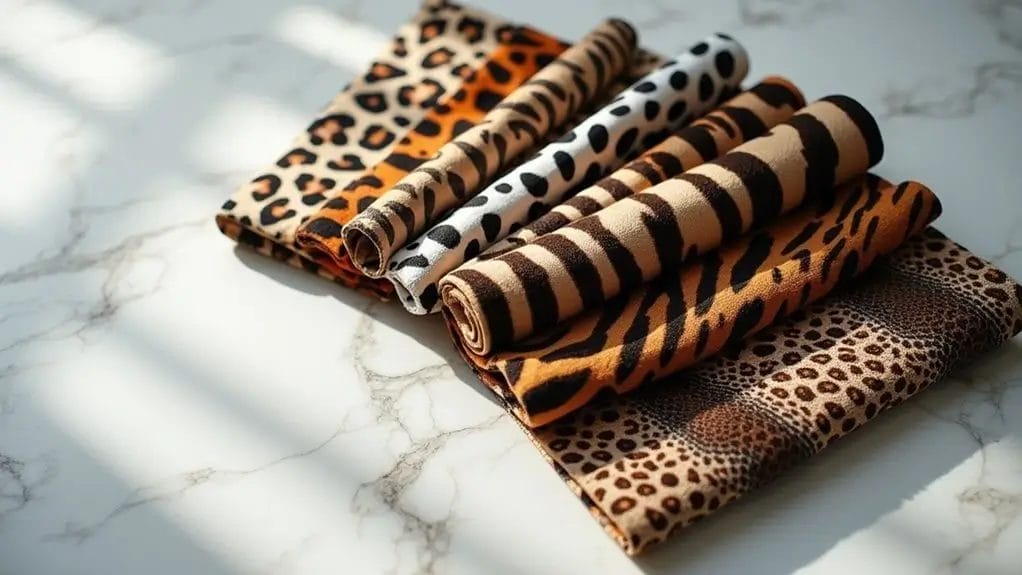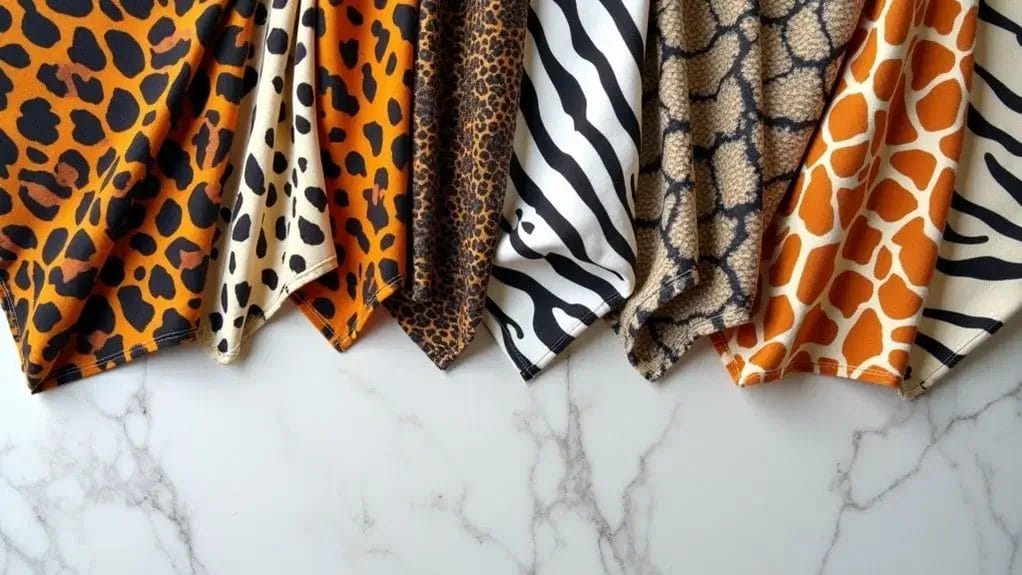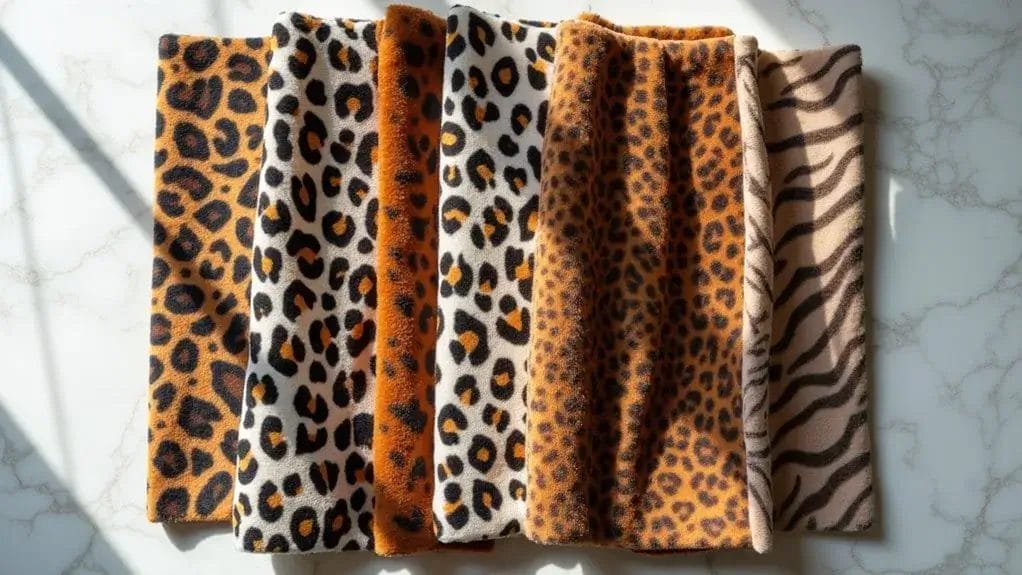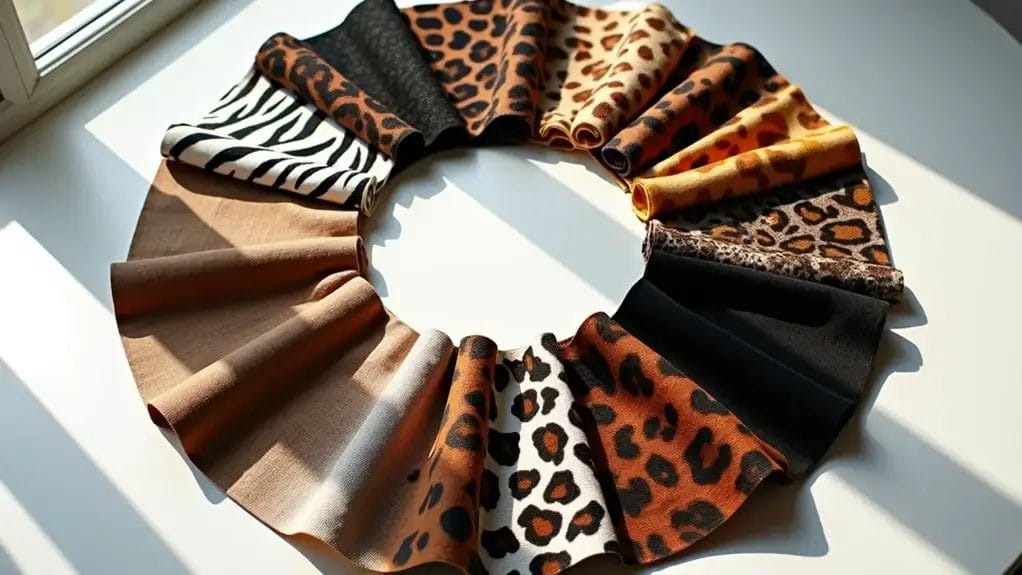You'll find that animal print fabrics have evolved far beyond their traditional safari-inspired roots. From the iconic rosettes of leopard to the geometric patches of giraffe, each pattern brings its own fabrication challenges and design possibilities. Whether you're working with cotton, silk, or synthetic blends, these prints can transform your projects into bold fashion statements or sophisticated decor elements. Understanding the distinct characteristics of each animal print will help you make informed choices for your next textile endeavor.
Key Takeaways
- Leopard print features distinctive rosettes and is available in various materials like cotton, silk, and velvet for fashion applications.
- Zebra print consists of bold alternating black and white stripes, commonly used in both upholstery and clothing designs.
- Snake print showcases scale patterns typically printed on silk and faux leather, available in natural tones and bold finishes.
- Giraffe print displays warm geometric patches ideal for sophisticated home decor and apparel projects.
- Cow print presents black and white spotted patterns popular in modern farmhouse aesthetics and contemporary fashion pieces.
Why Choose Animal Print Fabric for your Projects?

Animal print textiles offer you a perennial design element that's transcended decades of fashion evolution and interior design trends.
You'll find these versatile patterns integrate seamlessly across multiple fabrications, from plush velvets to lightweight chiffons, making them adaptable for various project applications.
The inherent neutral color palettes of most animal prints allow you to pair them effortlessly with solid fabrics or mix them with complementary patterns for sophisticated, on-trend compositions.
Timeless Appeal in Fashion
Throughout fashion history, exotic prints have maintained their status as a coveted design element, with leopard, zebra, and snake patterns leading the trend-forward aesthetic.
You'll find these timeless motifs gracing everything from haute couture runways to ready-to-wear collections, proving their enduring appeal across decades.
When you're selecting fabrics for your wardrobe, animal prints offer versatility that transcends seasonal trends.
Whether it's a silk chiffon leopard-print blouse or a structured snake-print jacket, these patterns create an elegant, sophisticated look.
The key lies in choosing quality fabrications that elevate the print's natural characteristics while maintaining their fashion-forward appeal.
Versatility
The adaptable nature of exotic prints makes them an exceptional choice for diverse sewing and design projects. You'll find that animal patterns work seamlessly across different colors and fabric weights, from delicate silk charmeuse to sturdy upholstery materials.
These versatile prints can transform any outfit, whether you're creating statement pieces or subtle accents. You can incorporate animal prints into everything from handbags and scarves to full garments and home décor.
The pattern's inherent flexibility allows you to mix scales and colorways, making it easy to coordinate with both neutral and bold design elements. It's this adaptability that makes animal prints a timeless choice for your creative endeavors.
Easy to Style and Combine
When incorporating exotic prints into your design projects, you'll discover their innate ability to function as both neutrals and statement pieces. You can pair leopard spots with solid black for a classic fashion look, or mix zebra stripes with bold colors to create dynamic visual interest.
Animal prints serve as a versatile wardrobe staple that you'll find easy to coordinate with various patterns and textures.
Whether you're working with snake prints, cheetah spots, or tiger stripes, these patterns blend seamlessly with both minimalist and maximalist style aesthetics. They complement everything from geometric designs to floral motifs while maintaining their distinctive character.
Popular Types of Animal Print Fabric

Today's trendiest animal print textiles include iconic leopard spots, bold zebra stripes, rustic cow patterns, exotic snake scales, and sophisticated giraffe motifs.
You'll find these prints on diverse fabrications ranging from lightweight cotton poplin to luxurious silk charmeuse and stretchy performance knits.
Each print variation offers unique pattern repeats and colorways that you can incorporate into both fashion and home decor applications.
Leopard Print Fabric
Leopard print fabric remains a timeless favorite among fashion designers and home decorators, featuring distinctive rosette patterns in varying shades of tan, brown, and black.
You'll find classic leopard prints rendered in materials ranging from cotton and silk to velvet and synthetic blends.
The iconic spot pattern consists of dark rosettes with lighter centers, surrounded by negative space.
Modern interpretations include micro-leopard prints, oversized spots, and abstract variations.
When selecting leopard print fabric, you'll want to take into account scale - smaller prints work well for accessories, while larger patterns make bold statements in upholstery and statement pieces.
The animal print's versatility allows it to function as both a neutral and accent pattern.
Cow Print Fabric
Cow print fabric captures the distinctive black and white spotted pattern found naturally on Holstein dairy cows, offering a playful yet sophisticated addition to the world of animal prints.
You'll find this print material available in various fabrications, from cotton and polyester blends to luxurious velvets and faux furs. Unlike other animal print fabrics, cow patterns typically maintain a stark contrast between the base and spots.
The versatility of different animal prints makes cow pattern particularly appealing for both fashion and home décor. It's commonly used in western-inspired designs, contemporary urban fashion, and modern farmhouse aesthetics.
Zebra Print Fabric
Among the most iconic animal prints in textile design, zebra patterns feature bold, alternating black and white stripes that mimic the distinctive markings of African zebras.
You'll find this striking fabric print in both natural and stylized variations, with stripe widths ranging from narrow to broad. Modern textile manufacturers often experiment with color alternatives, though the classic black and white combination remains most popular.
When selecting zebra print fabric, you'll encounter options in cotton, silk, polyester, and velvet.
The pattern's versatility makes it suitable for upholstery, fashion, and home décor. Contemporary designers frequently incorporate asymmetrical zebra prints or digitally manipulated variations for a fresh twist.
Snake Print Fabric
Snake print fabric captivates with its mesmerizing scale patterns, intricate diamond-shaped markings, and sinuous designs derived from various species like pythons, cobras, and vipers.
You'll find this exotic material rendered in various techniques, from digital printing to embossed textures that mimic authentic reptilian scales.
The fashion industry frequently utilizes snake print on silk charmeuse, stretch jersey, and faux leather substrates. Common colorways include natural tones like brown, beige, and gray, though contemporary designers often experiment with bold neons and metallic finishes.
The versatile pattern works equally well on lightweight chiffons for flowing garments or sturdy upholstery for statement furniture pieces.
Giraffe Print Fabric
While snake prints embrace elongated scales, giraffe print showcases distinctive geometric patches characterized by irregular polygonal shapes and warm earth tones.
You'll find this popular animal print typically features honeyed browns and tans with darker borders creating a network of interlocking patterns.
The versatility of giraffe print fabric makes it an excellent choice for both apparel and home décor. Its organic geometric pattern offers a sophisticated alternative to more aggressive animal prints.
The print's adaptability allows for various interpretations, from realistic renditions to abstract interpretations, and works particularly well on materials like cotton, silk, and velvet.
Tiger Print Fabric
The bold striped pattern of tiger print fabric continues to dominate fashion and interior design with its dramatic orange base and striking black stripes.
You'll find this fierce animal design in various fabric weights, from lightweight silk charmeuse to heavy velvet and plush faux fur.
Tiger print fabric often incorporates rich amber and chocolate tones, creating depth and dimension.
While traditional tiger patterns maintain naturalistic striping, modern interpretations feature abstract variations and unexpected color combinations.
The fabric's versatility shines in both apparel and home décor, making bold statements in everything from evening wear to accent pillows.
Crocodile Print Fabric
Luxury meets sophistication in crocodile print fabric, which features a distinctive textural pattern of scaled segments arranged in interlocking formations.
You'll find this fashionable design among the most distinct types of animal prints, often appearing on leather, faux leather, and textile materials.
The eye-catching pattern typically showcases raised or embossed surfaces that mimic authentic crocodile hide's natural texture.
Modern manufacturing techniques allow for various scale sizes and finishes, from high-gloss to matte.
When selecting crocodile print fabric, you'll discover options ranging from small, delicate scales to bold, oversized patterns that make striking statement pieces.
Cheetah Print Fabric
Instantly recognizable for its irregular black spots against a tawny base, cheetah print fabric captures the wild aesthetic of nature's fastest land mammal.
You'll find this iconic animal fabric trending in both haute couture and ready-to-wear clothing collections, making it a versatile choice for your wardrobe.
When selecting highest quality fabrics in cheetah print, consider these key characteristics:
- Authentic patterns feature irregularly-shaped spots with distinct borders
- Premium options include silk charmeuse, velvet, and brushed cotton
- Color variations range from traditional golden-beige to fashion-forward interpretations in bold hues
This timeless print adds sophisticated flair to any garment while maintaining its wild appeal.
Dalmatian Print Fabric
Black-and-white spotted fabric pays homage to a distinctive breed's coat pattern. When you search for fabric with this iconic print, you'll find different types featuring irregular black spots scattered across a crisp white background.
The unique characteristics of dalmatian print include varying spot sizes, organic shapes, and random placement patterns. You'll commonly find this print on cotton, polyester, and stretch fabrics, making it versatile for both apparel and home décor.
Unlike other animal prints, dalmatian spots maintain their popularity through a clean, graphic aesthetic that's both playful and sophisticated.
How to Choose the Right Animal Print Fabric

When selecting an animal print fabric, you'll need to align your project requirements with characteristics like fabric weight, drape, and durability.
The scale of the print pattern—whether micro, medium, or oversized—must complement your garment silhouette or upholstery dimensions.
You'll also want to evaluate how the print's colorway harmonizes with your existing palette, considering both traditional neutrals and contemporary fashion-forward combinations.
Consider Your Project Type
Selecting animal print fabric requires careful consideration of your specific project requirements and end-use application.
Each craft endeavor demands different fabric properties to achieve ideal results.
- For garment construction, choose lightweight stretch fabrics like jersey or silk charmeuse for fluid draping, or structured wovens like cotton sateen for tailored pieces.
- For upholstery projects, opt for durable materials like jacquard or chenille that can withstand heavy use.
- For accessories and craft items, select suitable materials like canvas, felt, or faux fur depending on the item's purpose and wear expectations.
Evaluate Print Scale and Pattern
Beyond choosing the right material type, the scale and pattern of animal prints greatly impact your project's visual impact. When selecting your fabric, you'll find a wide variety of options, from small-scale leopard spots to oversized zebra stripes.
Consider how the scale relates to your project size - larger prints work better on substantial pieces, while smaller patterns suit delicate items.
Different animal prints create distinct moods: cheetah spots feel modern and subtle, while tiger stripes make bold statements.
The pattern's direction also matters - vertical stripes elongate, while scattered spots distribute attention evenly across your piece.
Assess Color Combinations
Three essential color elements define successful animal print fabrics: the base color, the pattern color, and any accent highlights. When evaluating color combinations, you'll find many different options that range from naturalistic to avant-garde interpretations.
- Traditional palette: Choose earthy tones like tan, brown, and black for authentic leopard prints, or black and white for zebra patterns.
- Contemporary color: Explore bold neons, pastels, or metallic bases with contrasting pattern colors.
- Seasonal adaptations: Select warm autumnal tones or cool summer hues to align with current fashion trends.
Consider the fabric's end use when selecting color intensity and contrast levels.
Creative Applications for Animal Print Fabric

You'll find endless possibilities for incorporating animal print textiles across fashion, accessories, and interior design applications.
From statement blazers and midi skirts in leopard jacquard to zebra-print upholstered accent chairs, these bold patterns can transform basic pieces into eye-catching focal points.
Animal prints work exceptionally well for smaller-scale projects like clutch bags, throw pillows, and fabric-covered storage boxes, allowing you to experiment with different scales and colorways of these timeless motifs.
Fashion and Clothing Projects
Animal print fabrics create endless possibilities for fashion-forward clothing projects, ranging from statement outerwear to subtle accent pieces.
You'll find designer-inspired patterns perfect for elevated apparel creations.
- Craft a leopard print wrap dress using silk charmeuse or lightweight jersey for fluid draping and sophisticated movement.
- Design statement blazers with cheetah or zebra patterns on structured cotton twill or wool blend fabrics.
- Create accent pieces like scarves, cuffs, or collars using snakeskin prints on silk chiffon or satin.
These versatile patterns work across seasons and styles, allowing you to incorporate wildlife-inspired elements into your wardrobe thoughtfully.
Home Decor and Interior Design
Interior designers embrace exotic animal prints to create dramatic focal points and luxurious accents throughout living spaces. You'll find these patterns elevating home decor through strategic placement of leopard-print throw pillows, zebra-upholstered ottomans, and snake-print window treatments.
The enduring popularity of using animal prints stems from their versatility in both modern and traditional settings.
When incorporating these bold designs, you'll want to balance their visual appeal with solid neutrals. Consider textural variations like velvet leopard spots, woven zebra stripes, or embossed crocodile patterns.
These fabrics work exceptionally well on accent chairs, area rugs, and decorative accessories.
Accessories and Small Projects
Crafters and DIY enthusiasts can transform small amounts of animal print fabrics into stunning accessories and portable statement pieces.
You'll find endless ways to incorporate these bold patterns into your DIY stock by creating eye-catching accents that make a statement.
- Sew a trendy clutch or handbag using leopard print cotton canvas paired with vegan leather trim.
- Fashion quick-make hair accessories like scrunchies or headbands using lightweight cheetah print silk charmeuse.
- Craft desk organizers or tablet sleeves combining zebra print upholstery fabric with coordinating solid materials.
These small-scale projects let you experiment with different animal prints while developing your sewing skills.
Frequently Asked Questions
How Do I Care for and Clean Animal Print Fabrics?
You'll want to cold wash your animal prints, use gentle detergent, and avoid harsh bleach. Dry on low heat, hang delicates, and spot-clean silk or viscose prints with specialized cleaners.
Can Animal Print Fabrics Be Used for Outdoor Furniture and Decorations?
You'll need UV-resistant, weatherproof animal prints for exterior use. These performance textiles feature fade-resistant dyes and water-repellent finishes for ideal outdoor durability.
Are Animal Print Fabrics More Expensive Than Regular Printed Fabrics?
You'll find animal prints typically cost 15-30% more than standard prints due to their complex rotary screening process, specialized dye requirements, and trendy market positioning in textile manufacturing.
Do Animal Print Patterns Fade or Wear Differently Than Solid Colors?
You'll notice animal prints generally fade like other patterns, but digital-printed designs may wear more visibly at stress points compared to yarn-dyed solids or screen-printed fabrics.
Which Animal Print Fabrics Are Most Suitable for Children's Clothing?
You'll find cotton zebra prints and leopard-patterned jersey knits are most kid-friendly, as they're durable, washable, and stretch well. Giraffe patterns on cotton twill work great for playwear too.
Conclusion
You'll find that animal print fabrics offer versatile design possibilities across multiple textile applications. Whether you're working with digitally printed leopard velvet, woven zebra jacquard, or embossed crocodile leather, each pattern brings its own technical considerations. When selecting your fabric, consider the substrate's weight, drape, and durability. Today's innovative printing technologies and sustainable materials mean you're not limited to traditional colorways or compositions.


0 comments